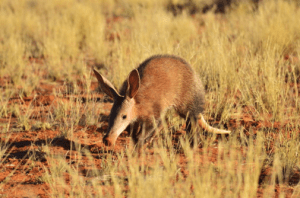TAG: GS 3: ECOLOGY AND ENVIRONMENT
THE CONTEXT: Recent studies, particularly from Oregon State University, highlighted the detrimental effects of climate change on aardvarks.
EXPLANATION:
- The warming climate has led to aridification in their landscapes, significantly impacting their survival chances.
- Aridification involves the drying and heating of the aardvarks’ habitats, causing disruptions in their distribution and movement patterns across the landscape.
Aardvarks
- Aardvarks, the nocturnal burrowing mammals found across much of sub-Saharan Africa, play a crucial role in the region’s ecosystem.
- Their habitat primarily includes savannah and semi-arid areas, where they contribute significantly by controlling termite populations that can otherwise damage human structures.
- Additionally, their burrows serve as essential habitats for various other species.

Research Insights: Understanding Aardvark Population Dynamics
- The study published in the journal Diversity and Distributions conducted by researchers at Oregon State University delved into a detailed examination of aardvark populations across various regions in sub-Saharan Africa.
- The research aimed to understand how the changing landscape due to aridification affected the genetic structure and population dynamics of aardvarks.
Methodology and Findings
- The researchers surveyed multiple areas in South Africa, Eswatini (formerly Swaziland), and Kenya to evaluate the impact of landscape on gene flow and genetic structure across different spatial extents.
- They collected and analyzed a substantial number of aardvark faecal samples, totalling 253, and scrutinized 104 samples for genetic information.
- At the local scale, the study revealed that aardvark populations in different regions within South Africa exhibited some level of separation.
- They found individual aardvarks in various locations, with closely related ones being separated by significant distances, up to 7.3 km apart.
- Genetic similarities were observed in aardvarks within 55 km, indicating their proximity as a determinant of genetic likeness.
Effects of Arid Areas on Aardvark Genetic Differentiation
- The research identified that arid areas across South Africa and Eswatini posed challenges to gene flow among aardvark populations.
- These areas acted as barriers, limiting genetic exchange among aardvarks.
- The study correlated this phenomenon with lower rainfall, resulting in reduced vegetation and subsequently fewer termites and ants—the primary diet of aardvarks.
Conclusion and Recommendations
- The study concluded that climate, particularly arid conditions, significantly influences the genetic structure of aardvarks.
- Arid areas restrict gene flow among populations and drive genetic adaptation associated with temperature changes.
- Consequently, the researchers recommend monitoring aardvark presence as an indicator of ecosystem changes attributed to aridification in sub-Saharan Africa.
Significance and Conservation Implications
- Understanding how climate change impacts species like aardvarks is crucial for informed conservation and ecosystem management.
- Aardvarks, despite being nocturnal, hard to trap, and existing in low densities across vast landscapes, play a vital role in maintaining ecological balance.
- Addressing the challenges they face due to climate change-induced aridification is imperative to ensure their continued presence and the overall health of sub-Saharan ecosystems.


Related posts
GST 2.0-NEXT‑GEN GST
French System of government and its comparison with India
A CASE OF EMPATHY: THE SC TO THE SOLDIER’S RESCUE